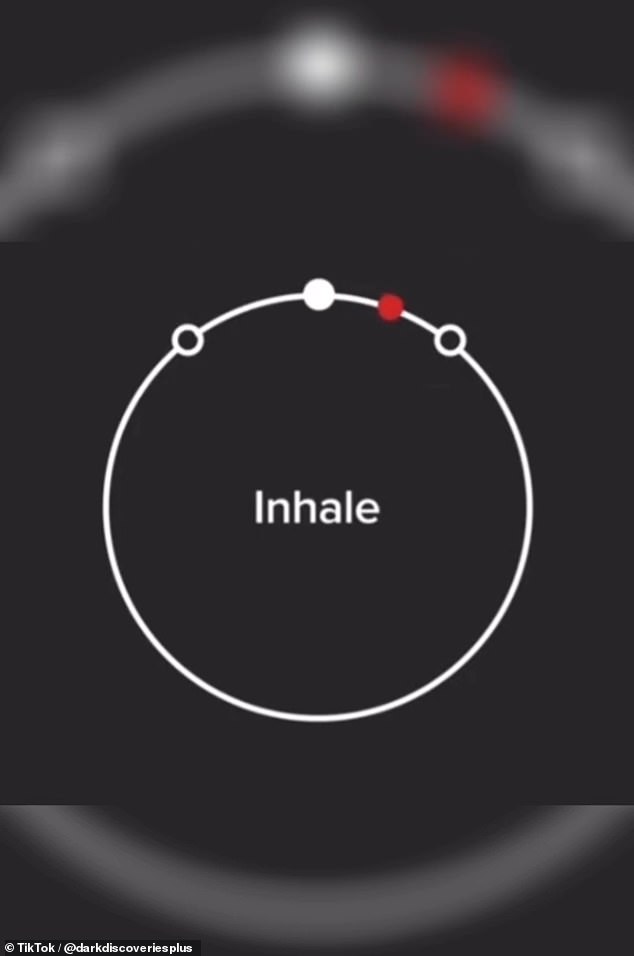The popular TikTok breathing test to detect if YOU have ‘military-grade lungs’
If you’ve ever aspired to become an elite Navy SEAL, you’ve probably tried the military-grade breath-holding techniques used by the most elite special forces in the field.
The average SEAL can hold his breath for about three minutes during high-pressure underwater exercises designed to simulate life-threatening scenarios, but the average American doesn’t have to undergo the same rigorous testing to see how well his lungs are working.
Lung capacity tests have popped up all over TikTok, where users post videos showing a countdown of about 40 seconds. The first few should be devoted to a deep inhalation, followed by a longer period of holding the breath before exhaling.
The online tests, while much less strenuous than the versions aspiring SEALs must complete, were easy for some people, while many others said they “almost fainted,” “turned blue” and “saw my grandma halfway through.”

The user is supposed to inhale deeply for about four seconds before holding their breath for the time it takes for the dot to move clockwise to the other side for the ‘exhale’.
TikTok is saturated with videos made by average citizens claiming that if you can hold your breath for about 40 seconds without lights appearing in your environment, you might want to consider a career in the military.
Named for the environments in which they operate (sea, air and land), Navy SEALs are an elite military force, famous for invading the Pakistani compound of terrorist Osama bin Laden, who train day in and day out to prepare for eventual to attack. possible war scenario.
Their grueling training exercises include one where a candidate lies face down in a pool of water after the instructors tie knots in their breathing valve, forcing them to remain calm with little oxygen, while also having to untangle the knots before returning coming upstairs.
The tests on TikTok are much simpler and require viewers not to leave their office chair. Simply breathe deeply for about four seconds, which many online say is the hardest part, and then hold that breath for 40 to 50 seconds. Then release a measured exhale.
The simpler layman’s test is strikingly similar to one used by the British Royal Air Force during World War I through about 1939 to measure a military candidate’s physical fitness.
Men were instructed to make a full exhalation, followed by a deep inhale, and then hold it for as long as possible, which averaged about 45 seconds.
Although the test was used at the beginning of World War II, years before scientists began to realize that such a test was a poor measure of physical fitness, with one saying that it only measures a person’s ability to withstand discomfort, and not the capabilities of his body. adapt to use oxygen more efficiently.
An avid cardio enthusiast can hold their breath more easily because their lungs are stronger, while someone who vapes or smokes regularly will likely have more difficulty.
A 2017 study conducted by doctors in India found that smokers could hold their breath for 34.85 seconds, while non-smokers was able to hold it for 46.61 seconds.
When someone holds their breath, whether training to become a military machine or swimming in the pool with friends, the body compensates for the sudden interruption of oxygen supply.
By holding your breath, oxygen no longer enters, and carbon dioxide cannot leave the body because exhalation has stopped. That CO2, instead of being released, is able to cross the blood-brain barrier, a network of blood vessels and tissue that serves as a protective layer lining the inside of the brain.
This can cause a drop in the delicate pH balance of the blood. The brain then sends an urgent signal to the lungs to exhale that harmful CO2.
A small number of studies have reported some health benefits of practicing breathing techniques, including one from 2015 that reported, albeit in salamanders, that they might help regenerate brain tissue.
Another study, this time in 2014, argued that the exercises could activate body functions fight or flight response while producing anti-inflammatory agents in the body that can help mediate an overzealous immune system response to foreign invaders or one’s own cells.
Doctors sometimes perform their own versions of lung function tests, but none where the patient is asked to inhale and hold their breath for a certain number of seconds.
If a doctor suspects that his patient who is having difficulty breathing has lung problems, he may perform one of several lung function tests.
One of these is called spirometry, which requires a person to inhale and exhale through a mouthpiece with the nose pinched shut. The mouthpiece is connected to a machine called a spirometer, which measures the amount and speed of airflow over a period of time.
A doctor may perform another test to measure lung volume, which, like the spirometry test, requires the patient to wear a nose clip and breathe in and out through a mouthpiece, this time in an airtight chamber that resembles a telephone booth. The pressure change in the cabin helps measure lung volume.
They may perform another type of test in which patients are asked to ride a stationary bike or walk on a treadmill while connected to monitors and machines that measure blood oxygen and blood pressure levels and heart rate.
